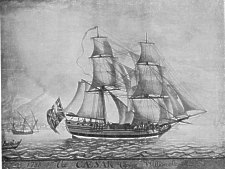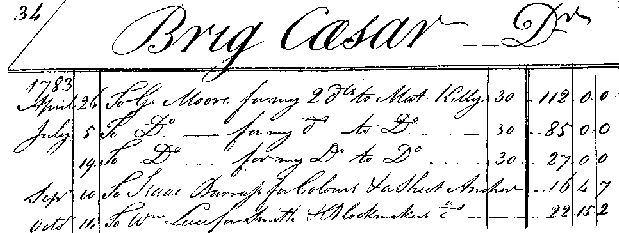
Old watercolour - the Brig Caesar anchored in Bay of Naples, 1788
[J Manx Museum vol III #45 pp63/5 1935]
THERE was brought to the Museum a few weeks ago for sale by a second-hand dealer, a framed old and dirty water colour painting of a sailing ship of eighteenth century build.

Old watercolour - the Brig Caesar anchored in Bay of Naples, 1788
Under the accumulation of dust at the foot one could faintly see the caption 1788: The Caesar: Captain . . . (the remainder being undecipherable). After the picture was purchased for the Museum at a price satisfactory to the dealer, it was seen that at the stern off the ship there was flying a flag hearing the Union Jack: with the Three Legs design. This and the name of the vessel led the curator to look up some old account books which had been given to him in 1924 along with many other precious relics of the Bacon family by Mrs. Macdougall Rawson, of Seafield. In scanning one of the old ledgers there, sure enough. were the accounts in detail of 'The brig Caesar' ! They commenced at 1783, when she was built, and ended in 1792.
It was the ledger of one of the foremost Douglas merchants of the 18th century, John Joseph Bacon, and dealt with the ' Adventures ' of his many vessels in far-off seas. His main activity was in Manx-cured red herrings, his ships trading, as far as the Baltic, the Mediterranean, and the Southern Seas.
The picture was cleaned by an expert, and it is now to be seen that, when originally painted, the noble vessel lay, with full sail set, in the beautiful Bay of Naples. In the background stands the famous city, and forty miles inland Vesuvius is shown with the smoke curling from the volcano. Small sailing boats are moving around and there is a pleasing activity and freshness. In the cleaning process the name of the Captain -- William Stowell -- was disclosed.
The picture as it appears to the eye is of much interest, but when the details in the Bacon ledger are seen it becomes an object capable of exciting emotion. The full caption, as disclosed after cleaning, reads 1788: THE CAESAR : CAPTAIN WLLIAM STOWELL.
It would appear from the details in the ledger that the brig was built at Douglas in 1783 by Matthias Kelly, delivery being made on 26th April of that year on the sum of £112 being paid over £353 8s. 3d. being paid in April, 1785. It is possible by reference to the ledger to learn something further about this notable ship.
Mr William Leece, a Manxman, and one of Liverpool's great merchants in the latter part of the 18th century, was Bacon's representative. He it was who furnished much of the ship's equipment and provided the coal, salt, tar, and the wood staves to make the many thousands barrrels which were necessary in connection with the curring of the herrings in the 'Fish House' in Douglas. He advanced wages to the seamen when the ship was at Liverpool and attended to the wants of the three apprentices.
The 'Adventur ' to Naples is made more realistic when we know certain facts such as, these
The Brig Caesar sailed from Douglas on the 25th October, 1788, having on board six hundred and fifty-seven barrels of red herrings cured in the ' Fish-house' in Douglas, there being one thousand fish in each barrel. She embarked from Liverpool on the 3rd November, for on that day the captain, William Stowell, got from William Leece £6 8s. 4d. 'primage'. Primage was a nautical term for ' hat money,' an allowance: given to the captain of a vessel by the shipper of goods for care in lading. William Leece gave the crew, for ' Hospital money ' 34/5. What is the sig-nificance of this item? As a premiumn on the insurance of the cargo, valued at £600, the sum of £12 6s. 0d. was paid. The net proceeds, according to the ledger, came to the handsome sum of £80414s. 0d. In the earlier part of the year, before the 'Adventure' to 'Naples, the Caesar had a trip to Dublin, from whence she took barley valued at £381 2s. 0d.
It may be interesting to note what were the activities of the Brig Caesar as shown in the records of her earliest charters. In 1783 she was at Nice, in France, to where she carried a cargo of herrings insured for £700.
In 1784 and 1785 she was at Naples with herrings, taking back cargoes of wine. She also went to Bristol and London with herrings.

Facsimile of a portion of folio 34 from the shipping ledger of John Joseph Bacon in the Manx Museum
There trust have been a deficiency in the fishings in the following year (1787), when only one hundred and forty barrels of red herrings; were sold to Naples for £147. But before the year was out she had sailed to ' Dominga,' or Dominica, in the British West Indies, one of the Leeward Islands. To that distant port the Manxmen brought £542 worth of red herrings, while rum and sugar comprised the return cargo. The net proceeds of ten hogsheads of sugar, divided with William Leece, realised £243 3s. 6d The details of the 1788 'Adventure' to Naples have been given. Before the end of that year she had gone to the West Indies, and had returned with sugar and perhaps rum, William Leece being debited with £138 worth. In 1789 she was as far as St. Martins in France with herrings, which brought in £659 14s. 2d., bringing back goods to the value of £1,102 5s. 6d. What these goods were is not divulged in the ledger, the insurance being £23 2s. 9d.
In the ledger there are very briefly recorded many incidents of an intimate character, such as wages to three apprentices, £4 10s. 0d. ; the selling of an old anchor to the brig Anne (William Cottiman of Ramsey, master) ; the purchase of a phaeton, when the ship was at London. for the sum of six guineas.
The last recorded transaction in the old ledger of the Caesar is that in 1792 she sold six hundred and fourteen barrels of red herrings to Naples and made, less commission and brokerage, the large sum of £921 15s. 5d.
The brig was, of course, named after the Caesars, a once well-known insular family which, for generations, owned Ballahick in Kirk Malew. John Caesar was Lieutenant of the Parish Company of Militia, and took an active part in the Rising of 1651, He was one of the delegates who met General Dukinfield, was a member of the Keys from 1643 to 1653, and was for six years Attorney-General.
John Joseph Bacon, a descendant of a member of the Caesar family through the female line, married Anne, daughter of the Rev. J. Cosnahan of Ballavilley (now ' Seafield '), Kirk Santan. His son, Major Caesar Bacon, fought at Quatre-Bras and Waterloo. The military uniform and many personal relics of this officer are in the Manx Museum.
The great-grandfather of the Rev. Thomas Edward Brown, the poet, was Captain Robert Brown the first. He married, in 1739, Margaret Cosnahan, a younger sister of the wife, of John Joseph Bacon, and daughter, it is believed, of the Rev. John Cosnahan, the owner of Ballavilley. Captain Robert Brown was, therefore, a brother-in-law of the owner of the Brig Caesar. It was known that he was the master of a foreign-going vessel, trading from Douglas, but it was not known what was the name of the vessel.
Captain Robert Brown the second was the son of the above. He was baptised in Douglas Chapel in 1761. It was known, too, that he was, like his father, the captain of a foreign-going trading vessel, and that he died at sea. His son. Robert the third, born in 1792, became, in due time, the father of the Manx poet born in 1830.
In the documents relating to the Brig Caesar. we find the record that the master in 1785 was ' Captain Robert Brown of Douglas.' In July of that year he was in charge of the 'adventure' to Marseilles. It could not have been Captain Robert Brown the first, for he died in 1769. His son, Captain Robert Brown the second, was born in 1761, so that he could only have been 24 years old when he took charge. Being the son of a skipper, he would be ' bred to the sea,' and also a grandson of the Vicar of Kirk Santan, his; education would not be neglected. Therefore, it is quite likely that Captain Robert Brown the second commanded the Caesar in many of her 'adventures.' His name disappears from the ledger after 1786, when William Stowell takes his place as master. The mate of the Caesar was William Kewley.
Who William Stowell was has not, so far, been discovered. There is every reason to believe him to be one of the Stowells of Ballastole in Kirk Braddan. The name of the mother of Jane, the wife of Captain Robert Brown the second, was also Jane Stowell. She was the daughter of ' Roger Stolle,' and was baptised at Kirk Braddan 20th March, 1720.
In the latter quarter of the 18th century there was much enterprise shown by the merchants of Douglas. Besides John Joseph Bacon, there was John Taubman of the Bowling Green, Castletown, and later of the Nunnery. He cured herrings at Derbyhaven and at the building recently demolished, called the 'Big Cellar' near to King William's College. There were also Heywood, Mylrea and Cannell, whose headquarters were at Douglas.
The ships engaged were : The 'Brig Bella' (Captain John Joseph Cosnahan), 'Diana' (Captain Qualtrough), ' Six Sisters' (Captain J. C. Cosnahan), ' Canny' (Captain Edward Kcgg), 'Elizabeth,' 'Nelly,' 'Brig Anne' (Captain William Cottiman of Ramsey), smack 'Joe' (Captain Robert Caine), 'Catherine' (Captain Thompson), 'Union' (Captain Robert Christian), 'Kitty and Polly,' ' Peggy,' 'Nancy,' the cutter 'Will,' 'George,' and ' Surrey,' etc.
They sailed to many ports in France, Spain, Italy, Sicily, to the Channel Isles, the Baltic, and even to the United States of America. It may well be claimed that our sea-faring ancestors, in their modest way, developed important trade routes, and thus contributed to the growth of international commercial intercourse and thus winning the goodwill of foreigners.
Some of the ports mentioned in the Bacon ledger as having been traded with between 1783 and 1792 are London, Bristol, Plymouth, Derry, Dublin, Nice, Marseilles, Bordeaux, Trapani, Lisbon, Genoa, Cadiz, Oporto, St. Martin, St. Abes, Port Charles, Malaga, Larnbrecht, Campo Marino, Gibraltar, Teneriffe, Civita Vecchia, Naples, Leghorn, Venice, Dominica, Madeira, Lucia, Savannah, Jamaica, Larnatt. St. Kitts, West Indies, Memel, Gothenburg, Bergen, Hamburg, Elsinore, Newfoundland, Halifax. Charlestown, Carolina.
The William Leece, already mentioned as Bacon's representative, was an important figure in the mercantile world of Liverpool. It was after him that Leece Street, near Bold Street, was named. His daughter, Elmor, heiress to his estate, married, in 1777, James Drinkwater, who afterwards became associated with him in his business. James Drinkwater was Mayor of Liverpool in 1810, and in 1837 laid the foundation stone of St. George's Hall. Deemster Sir William Leece Drinkwater was the grandson of James Drinkwater.
Among the important merchants with whom Bacon did business, according to his ledger, besides William Leece and the Drinkwaters, were : George Moore, a Manx merchant, of London: John Taubman, Hugh and John Cosnahan ; John and Robert Caesar; Lewis Geneste ; Patrick Tobin ; Matthews ; John Corlett ; John Quillin of Faroe; Thomas Moore of Ballasalla; John Stowell ; and Coultry Cannell.
|
|
||
|
|
||
| Any comments, errors or omissions gratefully received MNB
Editor HTML Transcription © F.Coakley , 2010 |
||